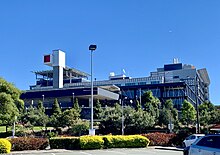Princess Alexandra Hospital, Brisbane
| Princess Alexandra Hospital | |||||||||||
|---|---|---|---|---|---|---|---|---|---|---|---|
ICAO : YPRI | |||||||||||
| |||||||||||
| History | |||||||||||
| Opened | 1959 | ||||||||||
| Links | |||||||||||
| Website | metrosouth.health.qld.gov.au | ||||||||||
| Lists | Hospitals in Australia | ||||||||||
The Princess Alexandra Hospital (PAH) is a major Australian teaching hospital of the University of Queensland, located in Brisbane, Queensland. It is a tertiary level teaching hospital with all major medical and surgical specialities onsite except for obstetrics, gynaecology, paediatrics, and medical genetics. It has a catchment population of 1.6 million people with 1038 beds and 5,800 full-time equivalent staff.[1] In 2005, the hospital received Magnet Recognition.
The hospital is located on
History
The hospital is built on the site of the 1883 Diamantina Orphanage, named after Diamantina Bowen, wife of the first Governor of Queensland. In 1901, it became Diamantina Hospital for Chronic Diseases. In 1943, it became the South Brisbane Auxiliary Hospital and then the South Brisbane Hospital in 1956.[2]
In 1959, it became the Princess Alexandra Hospital and was opened by and named after HRH Princess Alexandra, to mark the Centennial of Queensland. In 2000, a new building was opened to replace the ageing red-brick hospital complex built in the 1950s.[2] The current emergency department is situated on the site of the former nurses' quarters building, while the demolished pathology wing was located at the front of the campus off Ipswich Road.
Major milestones for the hospital included: opening of its first short-stay medical assessment unit in 1960, dialysis unit in 1963, ICU in 1964 (which was a 12-bed bay in the operating theatre recovery area), spinal unit in 1965, renal transplant unit in 1969, and coronary care unit in 1971.[3]
Electronic health records
It was the first hospital in Queensland to be fully digitised in 2016, a process led by Dr Stephen Ayre, a former general practitioner, who was then the executive director. Observations and vital signs from patient monitoring devices are automatically uploaded to patient records. All records are visible to all clinicians. Within a year this resulted in significant benefits:
- 14% fewer drug administration and monitoring errors
- 33% fewer drug dispensing and supply incidents,
- 17% fewer emergency readmissions within 28 days of discharge,
- drug costs per weighted activity unit came down by 14%,
- 56% fewer stage 3 & 4 hospital-acquired pressure ulcers
- healthcare associated infections down 37%.
- early identification of deteriorating patients went up by 59%.[4]
Units
Queensland's spinal injuries unit and the liver and kidney transplantation services are based at the hospital. The Cardiothoracic Surgery Unit opened in 1998. In the following years the unit performed more than 10,000 operations.[5]
Emergency department expansion

From 2009 to 2011 major expansion works were undertaken, including the doubling in size of the emergency department, the construction of a helipad with express elevators, and new oncology bunkers for cancer treatment.[6][7][8]
Centres
The P.A. Foundation is located at the Princess Alexandra Hospital. The foundation raises money for medical research on the P.A. hospital campus. In April 2008, the Diamantina Institute for Cancer, Immunology and Metabolic Medicine was opened at the hospital.
Transport
The PA Hospital can be accessed by the dedicated
See also
- Healthcare in Australia
- Lists of hospitals
- List of hospitals in Australia
References
- ^ "Current projects". Department of Local Government and Planning. 8 December 2011. Archived from the original on 19 March 2012. Retrieved 16 December 2011.
- ^ a b "Diamantina Health Care Museum". Queensland Government. 4 July 2014. Archived from the original on 14 December 2014. Retrieved 14 December 2014.
- ^ Hall, Peter (1981). Princess Alexandra Hospital Silver Jubilee 1956-81.
- ^ "Metro South Health completes digitisation of its five hospitals at South East Queensland". Healthcare Global. 4 October 2018. Retrieved 1 December 2018.
- ^ "PA Hospital performs 10,000th cardiothoracic surgery". Queensland Health. 10 December 2013. Retrieved 1 February 2014.
- ^ "Projects – Princess Alexandra Hospital Emergency Expansion – Capworks Management". capworks.com.au. Retrieved 8 August 2015.
- ^ "Princess Alexandra Hospital Emergency Department Expansion Project in Woolloongabba, QLD – Cordell Connect". cordellconnect.com.au. Retrieved 8 August 2015.
- ^ "Princess Alexandra Hospital " BLP". blp.com.au. Archived from the original on 13 October 2015. Retrieved 8 August 2015.
- ^ "Diamantina Institute officially unveiled". Medical News Today. 22 April 2008.
External links
- PA Foundation. P.A. Hospital Foundation
- P.A. Hospital
